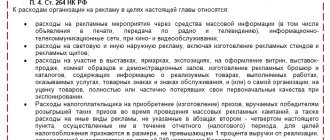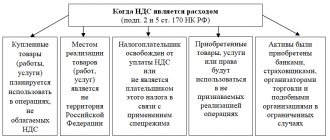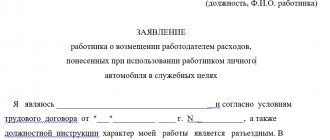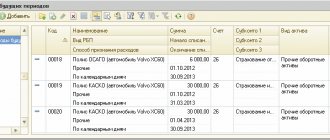Unregulated advertising expenses
The list of advertising expenses recognized by the Tax Code of the Russian Federation in full is strictly limited.
If an organization’s advertising expenses can be attributed to one of the groups listed above, then they reduce the tax base in full when calculating income tax. It should be noted that in paragraph 4 of Art. 264 only brochures and catalogs are indicated. Despite the fact that the Ministry of Finance of the Russian Federation considers booklets, flyers and leaflets to be a type of advertising brochures, disputes about classifying them as non-standardized expenses are not excluded.
Let us note some nuances that must be taken into account when accepting non-standardized advertising expenses for accounting, i.e., including the full amount of expenses.
- To accept advertising expenses in the media as such, you need a copy of the certificate of registration as a media outlet of the counterparty placing your advertisement.
- The Ministry of Finance of the Russian Federation in its letter dated June 15, 2011 No. 03-03-06/2/94, referring to Art. 16 of the Law “On Advertising” dated March 13, 2006 No. 38-FZ, indicated: in order for an advertisement published in a print publication that does not work on advertising to be considered with features suitable for advertising standards in print media, it must include the appropriate label - “ Advertising" or "On the basis of advertising".
- If an advertising product, for example a billboard, has a cost of over 100,000 rubles. and is intended for use longer than 12 months, then the costs for it are taken into account through depreciation charges.
There is increased interest among tax authorities in assessing non-standardized advertising expenses. In order to avoid deduction of advertising expenses in full, the accountant must be scrupulous with the documents confirming non-standardized advertising expenses. The main requirement, in addition to those generally accepted for primary documents, is confirmation that these expenses are included in those mentioned in paragraph 4 of Art. 264 Tax Code of the Russian Federation.
If you have access to ConsultantPlus, check whether you are correctly taking into account advertising costs when calculating taxable income. If you don't have access, get a free trial of online legal access.
Income tax: advertising or entertainment expenses?
Accounting for the costs of souvenirs transferred to counterparties largely depends on the event within which they are transferred:
- there is an advertising campaign (advertising expenses);
- an official reception and service for representatives of other organizations was held (representation expenses).
According to subparagraph 28 of paragraph 1 of Article 264 of the Tax Code of the Russian Federation, expenses for advertising manufactured (purchased) and (or) sold goods (works, services), taxpayer activities, trademarks and service marks, including participation in exhibitions and fairs, are considered other expenses related to with production and sales.
Let us turn to the provisions of the Federal Law of March 13, 2006 N 38-FZ “On Advertising” and determine what products can be classified as advertising. According to Article 3 of this law, advertising is information disseminated in any way, in any form and using any means, addressed to an indefinite number of persons and aimed at attracting attention to the object of advertising, generating and maintaining interest in it and promoting it on the market.
Consequently, in order to recognize certain expenses as advertising, the relevant information must be disseminated among an indefinite number of people.
The opinion of the Federal Antimonopoly Service on which products should be considered advertising and who should be considered an indefinite circle of persons is contained in letters*:
- dated January 23, 2006 N AK/582 “On advertising for souvenir products”;
- dated October 30, 2006 N AK/18658 “On advertising products”;
- dated 04/05/2007 N ATs/4624 “On the concept of “indefinite circle of persons.”
*sent to the tax authorities for use in their work by letter of the Federal Tax Service of Russia dated April 25, 2007 N ШТ-6-03/ [email protected]
FAS explains the following. The concept of “unspecified circle of persons” refers to those persons who cannot be determined in advance as the recipient of advertising information and a specific party to the legal relationship arising regarding the sale of the object of advertising. Such a sign of advertising information as intended for an indefinite number of people means the absence in the advertisement of an indication of a certain person or persons for whom the advertisement was created and to whose perception it is directed.
The distribution of souvenirs with the organization's logo is considered distribution to an indefinite number of persons if it is impossible to determine in advance all those persons to whom such information will be communicated. The application of logos to souvenir products (pens, T-shirts, bags, calendars, etc.) is carried out for advertising purposes, regardless of the further distribution of these products to employees, partners of this organization or third parties, including on a free basis.
Based on the conclusion of the FAS, it can be assumed that if the recipients of advertising information are not specifically named on the souvenir products and it is transferred in accordance with business customs in order to establish and (or) maintain mutual cooperation to representatives of other organizations, then its cost is classified as advertising expenses. The Moscow Tax Service adheres to the same opinion in a letter from the Federal Tax Service of Russia for Moscow dated April 30, 2008 No. 20-12/041966.2. Advertising expenses for the purchase and application of a logo on souvenirs incurred by the organization during the reporting (tax) period are normalized and recognized for tax purposes in an amount not exceeding 1% of sales revenue for the period*.
*P. 4 tbsp. 264 Tax Code of the Russian Federation;
To document the fact of advertising expenses, the company needs to draw up expenditure documents, for example, an invoice for the transfer of souvenirs to the employee responsible for their distribution, and a report from this employee on the work done. In the primary documents for the disposal of presented gifts, it is enough to indicate only their value and quantity without indicating the addressee. This fact will confirm that information about the products is sent to an indefinite number of people, and therefore such expenses can be considered advertising expenses. If the organization can create such conditions, then the distribution of souvenirs can be considered as regulated advertising expenses.
According to subparagraph 22 of paragraph 1 of Article 264 of the Tax Code of the Russian Federation, entertainment expenses associated with the official reception and service of representatives of other organizations participating in negotiations in order to establish and maintain cooperation are classified as other expenses associated with production and sales.
According to paragraph 2 of Article 264 of the Tax Code of the Russian Federation, these include:
- expenses for holding an official reception (breakfast, lunch or similar event): representatives of other organizations to establish and maintain mutual cooperation;
- participants who arrived at the meeting of the board of directors (board);
- officials of the taxpayer organization;
According to the financial department, the list of entertainment expenses is closed and does not include the cost of purchasing souvenirs as gifts to counterparties*. But tax authorities have a different opinion: if souvenirs with symbols are presented to representatives of partner companies during an official reception in order to establish and (or) maintain mutual cooperation, their cost is classified as entertainment expenses for tax purposes**. The arbitrators*** share the same opinion.
*letters of the Ministry of Finance of Russia dated October 8, 2012 N 03-03-06/1/523, dated August 16, 2006 N 03-03-04/4/136;
**letters from the Federal Tax Service of Russia for Moscow dated April 30, 2008 N 20-12/041966.2, Ministry of Taxes of Russia dated August 16, 2004 N 02-5-10/51;
***decrees of the Federal Antimonopoly Service of the Moscow District dated October 5, 2010 N KA-A41/11224-10, dated January 31, 2011 N F05-16032/2010 in case N A40-55061/2010;
For tax purposes, these expenses are recognized within the limit: no more than 4% of labor costs for the reporting (tax) period*.
*P. 2 tbsp. 264 Tax Code of the Russian Federation;
Entertainment expenses are taken into account when determining the tax base only if they are economically justified and documented. Documents used to confirm entertainment expenses are*:
*letters of the Ministry of Finance of Russia dated November 1, 2010 N 03-03-06/1/675, dated March 22, 2010 N 03-03-06/4/26, November 13, 2007 N 03-03-06/1/807;
- an order from the head of the organization to incur expenses for these purposes;
- estimate of entertainment expenses (the price of souvenirs should appear there);
- contract for the production of souvenirs, primary documents for their transfer and write-off;
- an act on the implementation of entertainment expenses, signed by the head of the organization, indicating the amounts of expenses actually incurred;
- report on entertainment expenses incurred. It reflects: the purpose and results of the representative event;
- date and place of the event;
- event program;
- composition of the invited delegation;
- host party participants;
- amount of expenses for entertainment purposes.
When presenting souvenirs to specific individuals, a list of gifts should be drawn up. There are no approved forms for recording transferred souvenir products. For this reason, the preparation of this statement depends on the document flow rules of a particular organization.
Distribution of promotional products and VAT
Organizations resorting to measures to promote their goods, works or services on the market in the format of distributing advertising materials, it is important to remember one point. The Ministry of Finance of the Russian Federation in letters dated October 23, 2014 No. 03-07-11/53626, dated July 16, 2012 No. 03-07-07/64 draws attention to: only gratuitous delivery of brochures and catalogs for advertising purposes is exempt from VAT, regardless of their cost acquisitions. For all other products transferred for advertising purposes that have a material form, be it mugs, calendars with a company logo, etc., the rule applies: if the cost is 1 pc. handouts exceed 100 rubles; in case of transfer, VAT must be charged in accordance with the generally established procedure.
IMPORTANT! Since 2015, when calculating VAT for payment, you can take into account the full amount of input VAT on advertising expenses, without taking into account whether these expenses are regulated or not.
Standardized advertising expenses
In fact, any advertising expenses that are not directly listed in the list of non-standardized expenses can be safely classified as regulated.
IMPORTANT! Advertising is only the mass dissemination of information about a product, service, or work intended for a previously unclear environment.
To calculate income tax, the norm for advertising spending is 1% of revenue excluding VAT and excise taxes. Advertising expenses not included in expenses according to the standard and revenue of this reporting period are transferred to the next reporting period of the calendar year. As revenue increases, the volume of standardized advertising expenses that can be taken into account grows. At the end of the year, the maximum amount of standard advertising expenses taken into account can be calculated. The excess volume is not taken into account when calculating income tax.
Accounting
Advertising expenses are included in expenses for ordinary activities. This follows from paragraphs 5 and 7 of PBU 10/99. Such expenses must be documented (Part 1, Article 9 of the Law of December 6, 2011 No. 402-FZ). Since advertising is recognized as disseminated information, documentary confirmation requires not only the ordering of the advertisement itself, but also its actual distribution (Clause 1, Article 3 of Law No. 38-FZ of March 13, 2006).
Confirmation of advertising distribution, in particular, may be:
- reports from advertising distributors on the work done, for example, on the number of leaflets distributed;
- on-air certificates from television and radio stations;
- metro certificates regarding the provision of advertising services.
Similar conclusions are contained in letters of the Ministry of Finance of Russia dated September 6, 2012 No. 03-03-06/1/467, dated June 22, 2012 No. 03-03-06/2/71.
Advertising costs should be reflected in account 44 “Sales expenses” (Instructions for the chart of accounts). It is advisable to open a corresponding “Advertising Expenses” subaccount for this account.
Advertising expenses under the simplified tax system “income minus expenses”
According to Art. 346.16 of the Tax Code of the Russian Federation, organizations using the simplified tax system are allowed to take into account advertising costs in their expenses. Such costs are determined in the manner prescribed for calculating income tax. That is, all expenses are divided on the same basis into normalized and not. It is allowed to recognize advertising expenses, documented and economically justified, when calculating the single tax only after they have been paid. For organizations using the simplified tax system, revenue is accrued using the cash method, which also includes the received prepayment. The amount of normalized advertising costs is also calculated within 1% of it.
ConsultantPlus experts spoke about the nuances of accounting for advertising expenses under the simplified tax system. Study the material by getting free trial access to the K+ system.
You can get acquainted with all types of expenses that are used to calculate the single tax under the simplified tax system, with the procedure for their recognition in the article: “List of expenses under the simplified tax system “income minus expenses.”
Who is required to pay advertising tax?
Persons or enterprises of any form of ownership conducting advertising events must pay advertising tax.
In this case, actions fall under the following parameters:
- the product being advertised must be the property of the advertiser;
- The entrepreneur for whom the advertisement was developed must be registered in the Russian Federation.
Tax payment is also mandatory for foreign citizens who carry out their activities in the territory falling under the jurisdiction of the Russian Federation.
There is a list of organizations exempt from tax payments for advertising activities:
- political organizations, campaigning does not apply to advertising events;
- individuals promoting services without profit-making purposes;
- charitable foundations that do not engage in activities aimed at making a profit;
- adaptation and rehabilitation centers that help people free of charge.
The payer may not be the enterprise or person itself, but an advertising company. In this case, an amount to pay tax is added to the fee.
Accounting for advertising expenses
In accounting, advertising expenses are not subject to rationing and are included in the cost part at full cost in the reporting period in which they occurred, regardless of whether they were paid or not. Supporting documents are required for their recognition. This records the following:
- Dt 44 Kt 60 (76) - advertising services are reflected;
- Dt 44 Kt 10 - advertising products that are not a fixed asset are written off as expenses;
- Dt 44 Kt 02 - depreciation has been accrued on fixed assets used for advertising purposes.








